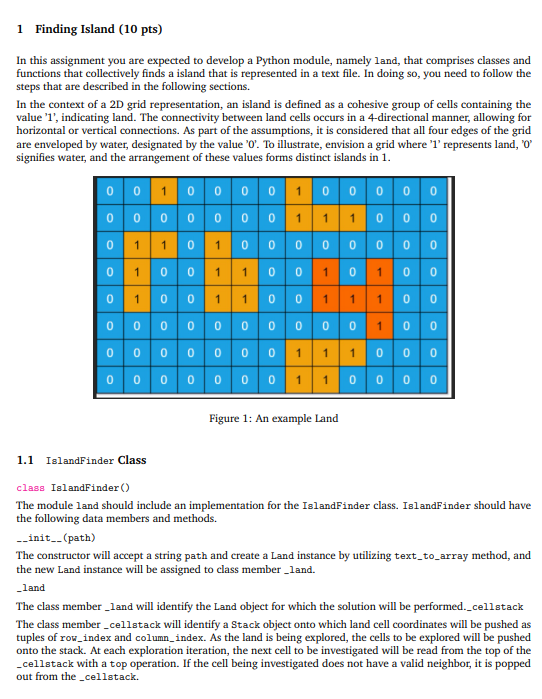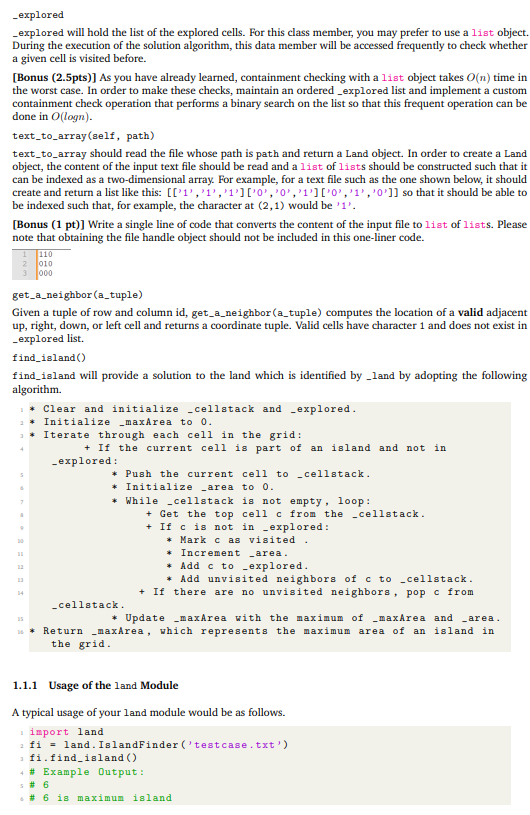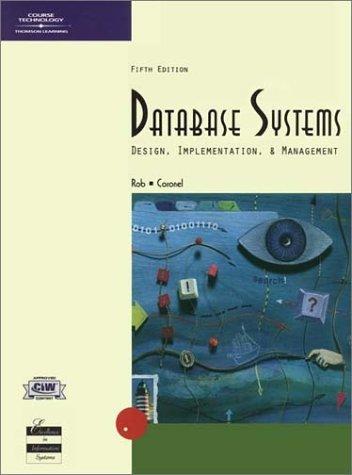Answered step by step
Verified Expert Solution
Question
1 Approved Answer
1 Finding Island (10 pts) In this assignment you are expected to develop a Python module, namely land, that comprises classes and functions that collectively


 1 Finding Island (10 pts) In this assignment you are expected to develop a Python module, namely land, that comprises classes and functions that collectively finds a island that is represented in a text file. In doing so, you need to follow the steps that are described in the following sections. In the context of a 2D grid representation, an island is defined as a cohesive group of cells containing the value ' 1 ', indicating land. The connectivity between land cells occurs in a 4-directional manner, allowing for horizontal or vertical connections. As part of the assumptions, it is considered that all four edges of the grid are enveloped by water, designated by the value ' 0 '. To illustrate, envision a grid where ' 1 ' represents land, ' 0 ' signifies water, and the arrangement of these values forms distinct islands in 1. Figure 1: An example Land 1.1 IslandFinder Class class IslandFinder() The module land should include an implementation for the IslandFinder class. IslandFinder should have the following data members and methods. -_init_-_ (path) The constructor will accept a string path and create a Land instance by utilizing text_to_array method, and the new Land instance will be assigned to class member _land. _land The class member _land will identify the Land object for which the solution will be performed._cellstack The class member _cellstack will identify a Stack object onto which land cell coordinates will be pushed as tuples of row_index and column_index. As the land is being explored, the cells to be explored will be pushed onto the stack. At each exploration iteration, the next cell to be investigated will be read from the top of the _cellstack with a top operation. If the cell being investigated does not have a valid neighbor, it is popped out from the _cellstack. _explored will hold the list of the explored cells. For this class member, you may prefer to use a list object. During the execution of the solution algorithm, this data member will be accessed frequently to check whether a given cell is visited before. [Bonus (2.5pts)] As you have already learned, containment checking with a list object takes O(n) time in the worst case. In order to make these checks, maintain an ordered_explored list and implement a custom containment check operation that performs a binary search on the list so that this frequent operation can be done in O(logn). text_to_array(self, path) text_to_array should read the file whose path is path and return a Land object. In order to create a Land object, the content of the input text file should be read and a list of lists should be constructed such that it can be indexed as a two-dimensional array. For example, for a text file such as the one shown below, it should create and return a list like this: [[1,1,11][00,0,1][0,,1,0]] so that it should be able to be indexed such that, for example, the character at (2,1) would be ' 1 '. [Bonus (1 pt)] Write a single line of code that converts the content of the input file to list of lists. Please note that obtaining the file handle object should not be included in this one-liner code. get_a_neighbor(a_tuple) Given a tuple of row and column id, get_a_neighbor (a_tuple) computes the location of a valid adjacent up, right, down, or left cell and returns a coordinate tuple. Valid cells have character 1 and does not exist in _explored list. find_island() find_island will provide a solution to the land which is identified by _land by adopting the following algorithm. * Clear and initialize _cellstack and _explored. * Initialize -maxArea to 0 . * Iterate through each cell in the grid: + If the current cell is part of an island and not in -explored: * Push the current cell to -cellstack. * Initialize _area to 0 . * While_cellstack is not empty, loop: + Get the top cell c from the _cellstack. + If c is not in -explored: * Mark c as visited. * Increment -area. * Add c to _explored. * Add unvisited neighbors of c to _cellstack. + If there are no unvisited neighbors, pop c from _cellatack. * Update _maxArea with the maximum of _maxArea and _area. * Return maxArea, which represents the maximum area of an island in the grid. 1.1.1 Usage of the land Module A typical usage of your land module would be as follows. import land fi = land. IslandFinder ('testcase.txt') fi.find_island() \# Example Output : \# 6 \# 6 is maximum island Build a Land class that internally maintains a two-dimensional array of characters which represents land structure. In such land representation, there exists two distinct cell types: island cells, water cells Land class should have a constructor accepting a list object satisfying land structure rules: - List object has to be comprised of lists of characters. - It should represent a mxn array where m>3 and n>3, and each of the internal lists should be of length n, and each cell of lists has to hold a single character (technically speaking, they have to be strings of length one). - Land structure have to include only ' 0 ' (water), ' 1 ' (island), and characters. No other characters should be allowed. Constructor should accept only those list objects that satisfy these rules, otherwise it should raise an InvalidLandException. Indexing of the land should start from the upper left corner of the array, in other words, the cell (0,0) should be the upper left corner of the two-dimensional array. Land class should have the following accessor functions. get_atart () get_atart () should return the starting cell (i.e., a tuple) of the land. Each cell should be represented as a tuple (rou_index, column_index). 1.3 Stack Class Develop Stack class that implements the Stack ADT that we covered in the lecture. The implementation provided in the textbook could be adopted. 1.4 Example Test Cases Below are some of the example text cases that might be helpful to you during the development. Text file including these examples is available on ODTUClass page. Please note that there will be many more test cases that we will use during the evaluation of your module. 1.4.1 Test Case 1 (Solution Exists) 1.4.2 Error Cases 2 Delivery Instructions Please hand in your module as a single file named as land.py over ODTUClass by 11:59pm on due date. An Assignment-01 page will be generated soon after the start date of this assignment. Should you have any questions pertaining to this assignment, please ask them in advance (rather than on the due date) for your own convenience. Whatever IDE you use, you have to make sure that your module could be run on a Python interpreter ( $> python. exe land.py) or iPython ( % run land.py)
1 Finding Island (10 pts) In this assignment you are expected to develop a Python module, namely land, that comprises classes and functions that collectively finds a island that is represented in a text file. In doing so, you need to follow the steps that are described in the following sections. In the context of a 2D grid representation, an island is defined as a cohesive group of cells containing the value ' 1 ', indicating land. The connectivity between land cells occurs in a 4-directional manner, allowing for horizontal or vertical connections. As part of the assumptions, it is considered that all four edges of the grid are enveloped by water, designated by the value ' 0 '. To illustrate, envision a grid where ' 1 ' represents land, ' 0 ' signifies water, and the arrangement of these values forms distinct islands in 1. Figure 1: An example Land 1.1 IslandFinder Class class IslandFinder() The module land should include an implementation for the IslandFinder class. IslandFinder should have the following data members and methods. -_init_-_ (path) The constructor will accept a string path and create a Land instance by utilizing text_to_array method, and the new Land instance will be assigned to class member _land. _land The class member _land will identify the Land object for which the solution will be performed._cellstack The class member _cellstack will identify a Stack object onto which land cell coordinates will be pushed as tuples of row_index and column_index. As the land is being explored, the cells to be explored will be pushed onto the stack. At each exploration iteration, the next cell to be investigated will be read from the top of the _cellstack with a top operation. If the cell being investigated does not have a valid neighbor, it is popped out from the _cellstack. _explored will hold the list of the explored cells. For this class member, you may prefer to use a list object. During the execution of the solution algorithm, this data member will be accessed frequently to check whether a given cell is visited before. [Bonus (2.5pts)] As you have already learned, containment checking with a list object takes O(n) time in the worst case. In order to make these checks, maintain an ordered_explored list and implement a custom containment check operation that performs a binary search on the list so that this frequent operation can be done in O(logn). text_to_array(self, path) text_to_array should read the file whose path is path and return a Land object. In order to create a Land object, the content of the input text file should be read and a list of lists should be constructed such that it can be indexed as a two-dimensional array. For example, for a text file such as the one shown below, it should create and return a list like this: [[1,1,11][00,0,1][0,,1,0]] so that it should be able to be indexed such that, for example, the character at (2,1) would be ' 1 '. [Bonus (1 pt)] Write a single line of code that converts the content of the input file to list of lists. Please note that obtaining the file handle object should not be included in this one-liner code. get_a_neighbor(a_tuple) Given a tuple of row and column id, get_a_neighbor (a_tuple) computes the location of a valid adjacent up, right, down, or left cell and returns a coordinate tuple. Valid cells have character 1 and does not exist in _explored list. find_island() find_island will provide a solution to the land which is identified by _land by adopting the following algorithm. * Clear and initialize _cellstack and _explored. * Initialize -maxArea to 0 . * Iterate through each cell in the grid: + If the current cell is part of an island and not in -explored: * Push the current cell to -cellstack. * Initialize _area to 0 . * While_cellstack is not empty, loop: + Get the top cell c from the _cellstack. + If c is not in -explored: * Mark c as visited. * Increment -area. * Add c to _explored. * Add unvisited neighbors of c to _cellstack. + If there are no unvisited neighbors, pop c from _cellatack. * Update _maxArea with the maximum of _maxArea and _area. * Return maxArea, which represents the maximum area of an island in the grid. 1.1.1 Usage of the land Module A typical usage of your land module would be as follows. import land fi = land. IslandFinder ('testcase.txt') fi.find_island() \# Example Output : \# 6 \# 6 is maximum island Build a Land class that internally maintains a two-dimensional array of characters which represents land structure. In such land representation, there exists two distinct cell types: island cells, water cells Land class should have a constructor accepting a list object satisfying land structure rules: - List object has to be comprised of lists of characters. - It should represent a mxn array where m>3 and n>3, and each of the internal lists should be of length n, and each cell of lists has to hold a single character (technically speaking, they have to be strings of length one). - Land structure have to include only ' 0 ' (water), ' 1 ' (island), and characters. No other characters should be allowed. Constructor should accept only those list objects that satisfy these rules, otherwise it should raise an InvalidLandException. Indexing of the land should start from the upper left corner of the array, in other words, the cell (0,0) should be the upper left corner of the two-dimensional array. Land class should have the following accessor functions. get_atart () get_atart () should return the starting cell (i.e., a tuple) of the land. Each cell should be represented as a tuple (rou_index, column_index). 1.3 Stack Class Develop Stack class that implements the Stack ADT that we covered in the lecture. The implementation provided in the textbook could be adopted. 1.4 Example Test Cases Below are some of the example text cases that might be helpful to you during the development. Text file including these examples is available on ODTUClass page. Please note that there will be many more test cases that we will use during the evaluation of your module. 1.4.1 Test Case 1 (Solution Exists) 1.4.2 Error Cases 2 Delivery Instructions Please hand in your module as a single file named as land.py over ODTUClass by 11:59pm on due date. An Assignment-01 page will be generated soon after the start date of this assignment. Should you have any questions pertaining to this assignment, please ask them in advance (rather than on the due date) for your own convenience. Whatever IDE you use, you have to make sure that your module could be run on a Python interpreter ( $> python. exe land.py) or iPython ( % run land.py) Step by Step Solution
There are 3 Steps involved in it
Step: 1

Get Instant Access to Expert-Tailored Solutions
See step-by-step solutions with expert insights and AI powered tools for academic success
Step: 2

Step: 3

Ace Your Homework with AI
Get the answers you need in no time with our AI-driven, step-by-step assistance
Get Started


